Y1U2B2 POSITIONS THROUGH CONTEXTUALIZING
Against eternal power struggles and cultural hegemony: Can Eastern and Western cultures form a relationship through communication methods?
Annotated Bibliography and Written Response
Gramsci, A. (1971) Selections from the Prison Notebooks of Antonio Gramsci. London: Lawrence & Wishart.
The project started as a response against the narrative implied in the concept of cultural hegemony offered by Gramsci. Cultural Hegemony is a tool used in political or cultural power dynamics where an authority in power positions a certain dominant culture to the point to be perceived as the norm, subduing and conquering marginalized cultures. This is to incite power and dominance against all groups, presumably determined by group identities. We see its relevance today where many movements on the far-left political spectrum critique and challenge dominant positions of power.
This narrative dictates that power is the only goal any group identity need to strive for, lest it lose its existence and never truly actualize. There will always be an oppressor and the oppressed, and therefore everything is a never ending power struggle. There is no reconciliation between group identities due to unbridgeable differences in culture and language. Therefore, because communication is not possible, the worldview believes the only way to respond to another group identity is to assert dominance. In our case, western dominant culture versus the east.
Agus, A.A. (2016) Relevansi Pancasila Sebagai Ideologi Terbuka di Era Reformasi. Makassar: Universitas Negeri Makassar.
“Maka ideologi Pancasila yang bersifat terbuka pada hakikatnya, nilai-nilai dasar (hakikat sila-sila Pancasila) yang bersifat universal dan tetap, adapun penjabaran dan realisasinya senantiasa dieksplisitkan secara dinamis reformatif yang senantiasa mampu melakukan perubahan sesuai dengan dinamika aspirasi masyarakat.”
“Therefore, the Pancasila ideology, open in its character and essence, contains foundational values (the essence of the principles) that is universal and unchanging, yet also contains its interpretations and realization continuously manifested dynamically and reformative that perpetually adapts to the changes of the people’s aspirations.” (Freely Translated)
The Republic of Indonesia holds values derived from Pancasila, and founding constitutions. These values were derived from an accumulation of various beliefs from all across the archipelago which consists of more than 300 unique ethnic groups. We believe that differences in language and culture are bridgeable through shared values, historical sentiments, and language. These values are crystalized into five main principles in the Pancasila, to put it briefly: Belief in God, just and civilized humanity, national unity, democracy, and social justice.
The timeless values and universal character of Pancasila contradicts the power struggle narrative proposed by Gramsci. Communication, grounded in universally inherent truths sustained by a fundamental belief in God as the origin and preserver of existence, facilitates a connection between disparate cultures, such as Eastern and Western ones.
Combining western culture and Indonesian makes me reflect on my own national identity. I am Indonesian, born and spent a childhood in Germany, living with a culturally Chinese minority, and Christian by conviction. Yet I am Indonesian because our values don’t exclude its people based on race or ethnicity. But how do these foreign elements play a part in my identity as an Indonesian? Do they need to be excluded, or is it part of it?
Jencks C and Silver N (2013) Adhocism: The Case for Improvisation. Massachusetts: The MIT Press Series.
Adhocism explores the idea of improvisation starting from available materials to create something new. This idea views any object is never a final perfect iteration and assumes it will always be subject to change depending on how we interact with the object by reassembling, recontextualizing, etc. It assumes the idea that any object that exists in the world is derived out of previous systems. Taking apart parts of a thing, then recontextualizing a part into something entirely new, suggests a neutral state of being for anything. There is no fixed essence of anything, since anything is dependent on what context it finds itself in.
With that in mind, how about mixing cultures together? The idea above opens the possibility for a culture to appropriate another’s as long as it fits its own context, i.e. Chinese calligraphy looks appropriate to represent an ethnically Chinese Indonesian.
Maurer, L. (2013) Conditional Design Workbook Valiz. Amsterdam: Valiz.
Last project, I explored how I could utilize the conditional design method to formulate a set of instructions on how to translate an eastern style packaging into a western one and vice versa. Yet, in context of the brief, the artwork is the process itself, a gradation of microsteps, gradual iterations of the eastern packaging’s elements slowly stripped away and replaced to look clean and westernly modern. Each packaging iteration’s meaning is dependent on this context. This context is assigned to each individual iteration. All iterations belong to the set, and isolating one results in the loss of its meaning. In the context of adhocism, this extracted part would be assigned another context.
Reflecting on these readings makes me see a common pattern. It makes me think about neutral states of symbols: are symbols detachable cleanly from its context? This in itself of course is assigning a context unto it, that of nihilism. Then the question should be is there really no limit as to how symbols can symbolize anything arbitrarily? The readings so far seem to suggest it that way.
Magritte, R. (1929) The Treachery of Images [Oil on Canvas]. [Online]. Available at https://www.bbc.co.uk/culture/article/20171205-magritte-and-the-subversive-power-of-his-pipe
The thought above reminds me of Magritte’s “this is not a pipe” painting perfectly embodies the absurdity and arbitrary nature of symbols. This piece challenges our understanding of symbols by contradicting the image of a pipe against a writing “this is not a pipe”, making us reflect on how we assign subjective meaning to the symbol. This work just further comes to show how personal experiences and cultural backgrounds affect how we understand a symbol. The same symbol could mean different things to different people. There isn’t one fixed totalistic meaning permanently fixated on a specific symbol.
Ogden, C. K and Richards, I. A. (1956) The Meaning of Meaning. London: Kegan Paul.
Ogden and Richards offer a diagram of how symbols form meaning that explains the phenomenon above. They offer a triad where a symbol is connected to thought/reference, which in turn relates to a referent. A dotted line connects symbol and referent, implying a superficial relationship. Any symbol can be used to represent any referent. This implies that symbols have infinite possible pairings with any referent. However, this infinite possibility ironically seems to me to dilute a symbol’s definitive meaning.
Each person has a different set of thought/reference and referent when talking about the same symbol. Implying no direct connection between the message we intend to convey versus what the receiving end of the conversation might think about.
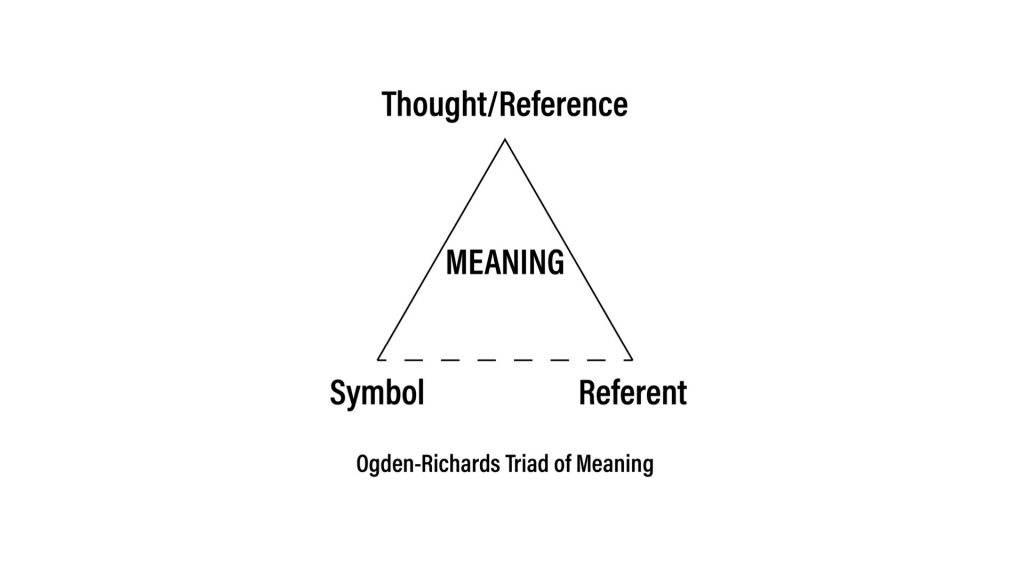
Eames, R. and Eames, C. (1953) A Communication Primer. [Online] Available at https://www.youtube.com/watch?v=kaDQlyXilSw
The introduction of the concept of noise in the Eames Brothers’ visual essay is interesting. It takes into account external noise that alters the symbol received by someone else, distorting the message. I attempted to incorporate Ogden-Richards’ triad of meaning into Eames’ own diagram. By adding the noise element and articulating each side of the communication’s symbol, thought and referent, we get a diagram as such:
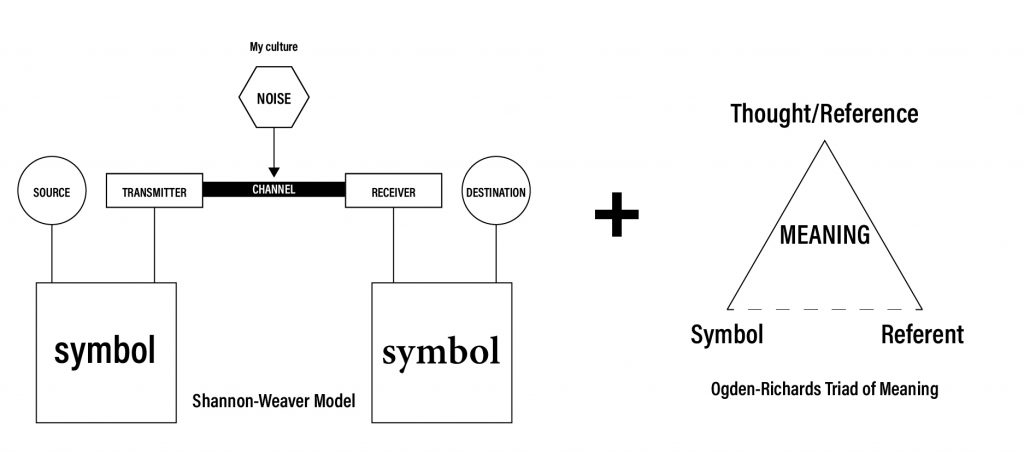
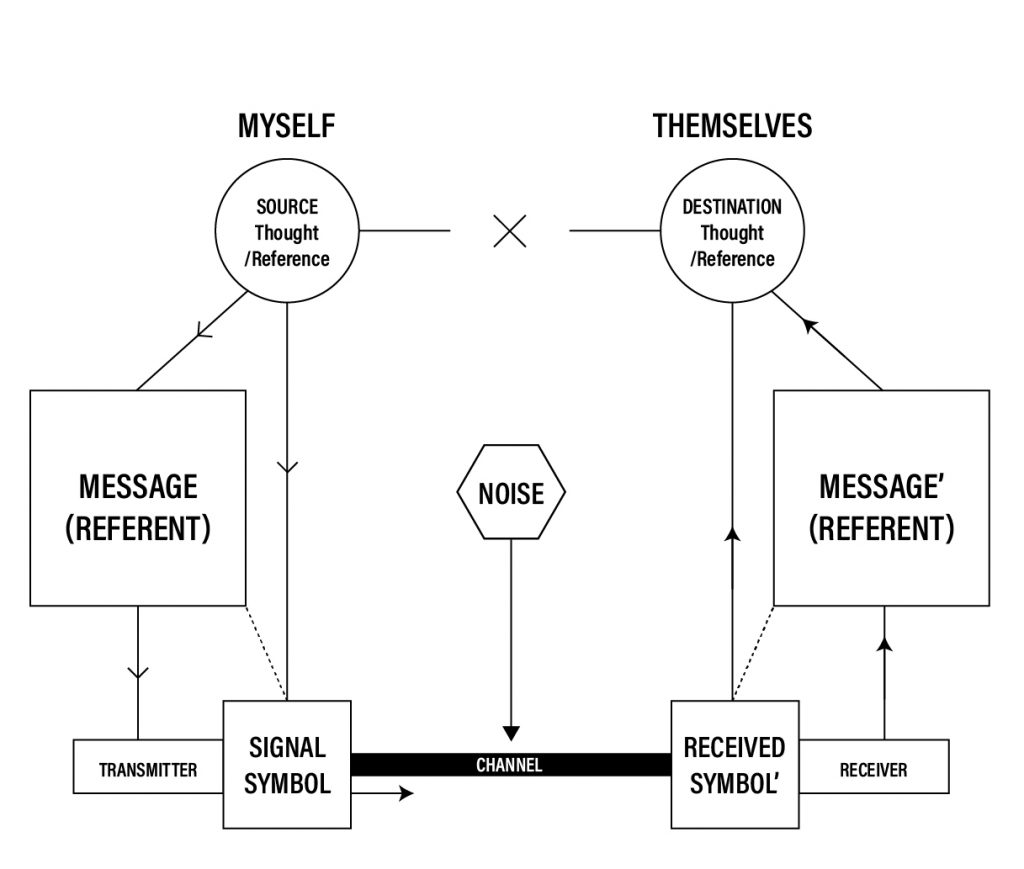
When I attempt to apply my own message “I am an Indonesian of chinese ancestry”, it might look something like this:
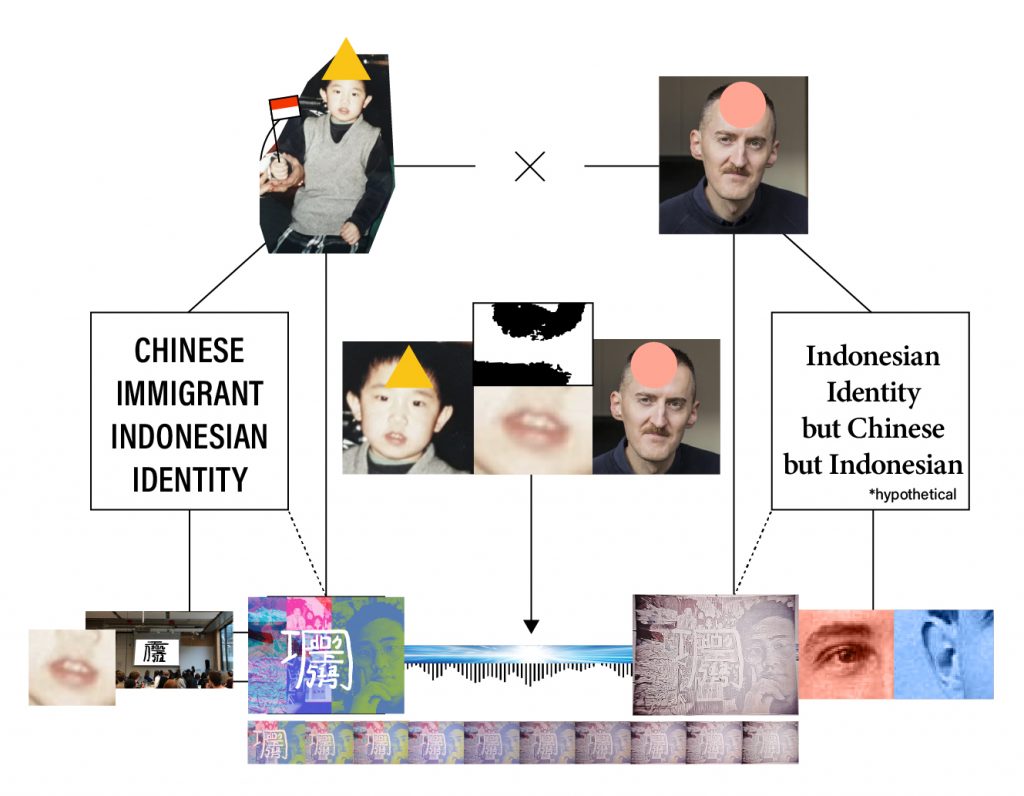
Take for example I would be talking to our beloved course master, Matthew. He has a completely different cultural background myself. So when I attempt to communicate that “I am a chinese immigrant indonesian” by use of images, sounds, my accent, and calligraphy, the noises of my accent, biases from each of our own heads, and light distortion, might arrive differently (hyperbolically) in Matthew’s understanding. I represent the distortion of symbols by noise by taking a picture of an image I made representing myself, sending it to WhatsApp, where I then took a picture again, and repeat. The distortion from the phone camera, and quality reduction in WhatsApp distorts the image to a point as you would see in the diagram, representing a distortion of the symbol Matthew might receive, distorting the message.

Neurath, O. (2010) From Hieroglyphics to Isotype. London: Hyphen Press.
Neurath’s system of isotypes share the same spirit Ogden-Richards have with their development of Basic English. Both seeked to simplify language in order to make communication more efficient and to avoid the distortions due to noise. Meanings are boiled down to its bare minimum to convey the same message, transcending language and cultural barriers, and International language of isotypes. Yet this results in the reduction and negligence of the nuance cultural diversity has in a nation. This implies that only the most efficient way to communicate a message is the best way to transfer messages. This is a good tool when needing to convey simple messages. But when it comes to more nuanced information, isotypes will fail to do so. Its limitation is parallel with its reductionist qualities. Therefore one could argue that by idolizing the use of efficient means of communication, it reduces cultural expressions into mere stereotypes (most widely understood) and hinders critical thought, also prone to be used as a tool for cultural hegemony, as initially discussed as demonstrated in the bibliography below.
Sanders, B. (1988). ABC: The Alphabetization of the Popular Mind. San Francisco: North Point Press.
The satirical force with which Orwell used Newspeak to serve as his portrait of one of those totalitarian ideas that he saw taking root in the minds of intellectuals everywhere can be understood only if we remember that he speaks with shame about a belief that he formerly held … From 1942 to 1944, working as a colleague of William Empson’s, he produced a series of broadcasts to India written in Basic English, trying to use its programmed simplicity, as a Tribune article put it, ‘as a sort of corrective to the oratory of statesmen and publicists.’ Only during the last year of the war did he write ‘Politics and the English Language,’ insisting that the defense of English language has nothing to do with the setting up of a Standard English.
Orwell’s experience using basic english to communicate with the British Indian people inspired him to write his dystopian novel Nineteen Eighty-four, where he likens simplified language (represented as the language “Newspeak”) as a weapon to control the people by simplifying the language so much, critical thoughts are discouraged, and only the government’s agendas are enforced. This story demonstrates the totalitarian qualities of efficient simplified language could mean to a culture. The pursuit of efficiency and to transcend cultural/language barriers resulted in the dictating of a reductionist culture, masquerading as a neutral uniter of all other cultures.
Looking at the Indonesian cultural identity this way will end in typical Java-centric stereotypes. My history will have nothing to contribute to this identity. Then, is there no place for my heritage and upbringing in Indonesian identity?
Le Guin, U. K. (2004) The Wave in the Mind. Colorado, Shambhala Publications Inc.
Le Guin proposes a more interpersonal perspective on communication. In her essay, “Telling is Listening”, Le Guin beautifully describes a more organic way to understand communication. According to Le Guin, communication is not just mechanical, but interpersonal, where telling and listening is like two oscillating objects with their own rhythms, affecting and changing each other, eventually harmonize and connect. In a form of a graph, and borrowing the external noise concept from before, it may look like this:
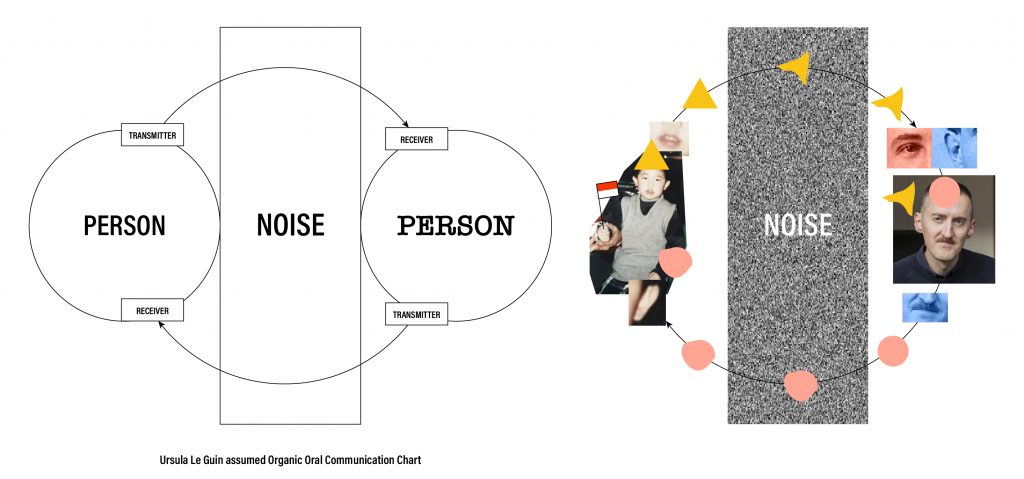
I would talk to Matthew with my own thoughts, it would go through noise, distorting it, and arriving and mixing with Matthew’s own understanding. His actions of listening to me also shapes my own symbols and meanings. The more we harmonize, the more we connect.
This made me think about why they will harmonize. In science there is something called natural frequencies. The phenomenon of two oscillating bodies harmonizing is inseparable from the inherent qualities of their natural frequencies. To me this implies that symbols may change and develop over the years, but there should be a stable meaning structure that dictates this change.
Lucier, A. (1981) I am Sitting in a Room [Audio Recording]. [Online]. Available at https://www.youtube.com/watch?v=fAxHlLK3Oyk [19 May 2025]
Talking about natural frequencies, I am reminded by Lucier’s audio work “I am Sitting in a Room”. His work is a good example of how natural frequencies from the room, microphone, and speaker may affect the symbols, which in the recording, eventually break down into white noise, leaving only some form of rhythmical sound waves. I copied Lucier’s work my own way with the phrase “I am Indonesian” and let my phone and iPad speak and record each other repeatedly, but at the end contrasting the final result of the distortions with my own original voice. This contrasts the difference between a speaker with intention, against a naturalistic distortion of sound waves relying solely on their respective natural frequencies. There is a difference demonstrated here that I think is worth taking into consideration, an inherent structure of intention within symbols as we use them today.
Steyerl, H. (2009) The Wretched of the Screen. London: Sternberg Press.
I am reminded by the journal “In Defence of the Poor Image”, where through the reduction of quality of videos and images, affected by innumerable transfers and gradual file corruption over decades, degraded into a visual vernacular of the fringes of a capitalist society. Distorted pixelated videos, shadows of its former past, representing a new way of rapid distribution of non-mainstream information, its existence actively defying the dominant capitalistic HD media. The poor images’ low quality give way for marginalized content to be accessible to marginalized communities. Yet, the irony of the poor image is that of representing the very system that caused its alienation, the capitalist system that values speed, efficiency, and rapid distribution. The parallel and seemingly unavoidable dependance of the poor image’s character toward its oppressor just comes to show to me even in defiance and a yearn for freedom, owes its existence forever within the shadow of the defied. This presupposing relationship to me puts into question the existence of an underlying structure, foundational to both of their very existence.
Written Response
Poythress, V. (1999) God Centered Biblical Interpretations. New Jersey, Presbyterian and Reformed Publishing.
”Hence, symbol and sense are perspectivally related. Each irreducibly involves the other, by virtue of coinherence. A symbol is not a symbol unless it symbolizes.”
I selected this book I read years ago because I was intrigued by the way it integrates faith and how we interpret reality. The book also has a chapter critiquing Ogden-Richards’ triad of meaning, “redeeming” it with a Christian faith based perspective. Now that these two world collide, I was interested to see how this view contrasts the secular view.
Poythress came from the neo-calvinist reformed tradition, stemming from John Frame, to Herman Bavinck. They often use a principle called “presuppositions”, an implicit assumption anyone has regarding their view of things that is usually taken for granted. Presuppositions regard neutrality as a myth, including in semantics, language, and meaning. The existence of a thing i.e. symbols will never stand on its own and always imply the existence of something it symbolizes, or a country implies the existence of land, culture, and people, the existence of language implies the existence of culture and human speakers, and so on.
Poythress argues the system of how we understand meaning is inherently tied to God as creator of the universe, including systems of science, communication, and language. If systems exist, in which our communication and mutual understanding can operate, it implies there is an intelligent designer. Letting nature develop itself through natural ways is impossible without clear intentional directions, as demonstrated by recordings and replays of speech through a phone and iPad, dissolving symbols into pure resonants.
The book asserts the base assumption that God is the creator of creation, including communication and language. As bearers of God’s image, our language mimics that of God’s. Interestingly, Poythress points out that any structures in the universe, including meaning, terms, communication, etc. share the same triadic patterns, analogous to the nature of the Christian Trinity. Father, Son, Holy Spirit, one God yet three in essence or persons. This is called Triperspectivalism
John 1:1 states “In the beginning was the Word, and the Word was with God, and the Word was God.” This is one of the verses in the bible directly talking about the trinitarian nature of the Christian God. There was the Word as the original speaker, the spoken Word inseparable from God, and the very existence and relationship is God’s very real presence. In Genesis 1 we also see that this “Word” created the universe using language, implying that language is the structure that sustains the fabric of reality. The same “Word” created human language we use, which is an analogy of the divine Word it was created from, a reflection of the original. And just as you can see the identity of an artist’s hand in his artworks, you can see God’s quality in creation.
What that quality is, we need to explain the nature of the trinity. There is no exhaustive way to explain the trinity, but to oversimplify, we could use the example of the nature of a three dimensional object. A thing existing in a three-dimensional plain always has a height, width, and length. The existence of any of these in the 3D space always implies the existence of the other. An object would never exists without any one of them.
According to Poythress, how meaning from terms is created also relies the satisfaction of a three-dimensional triad as seen below:
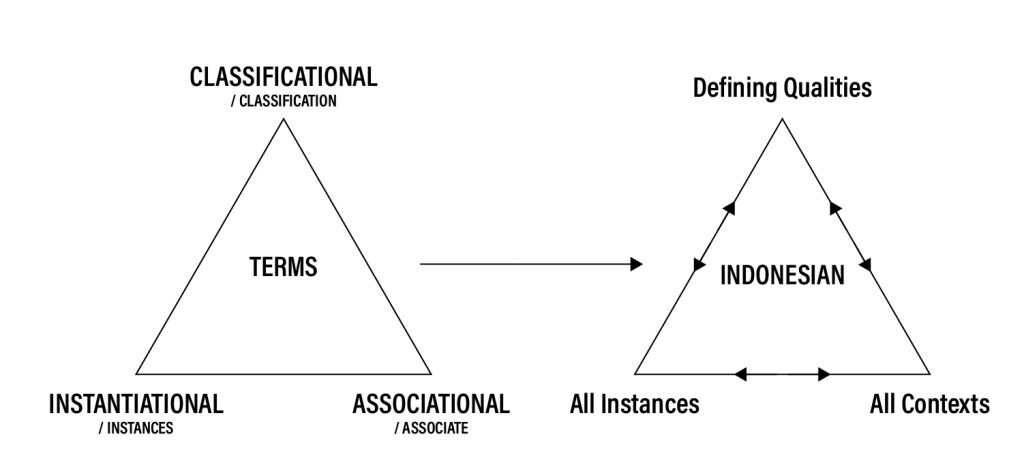
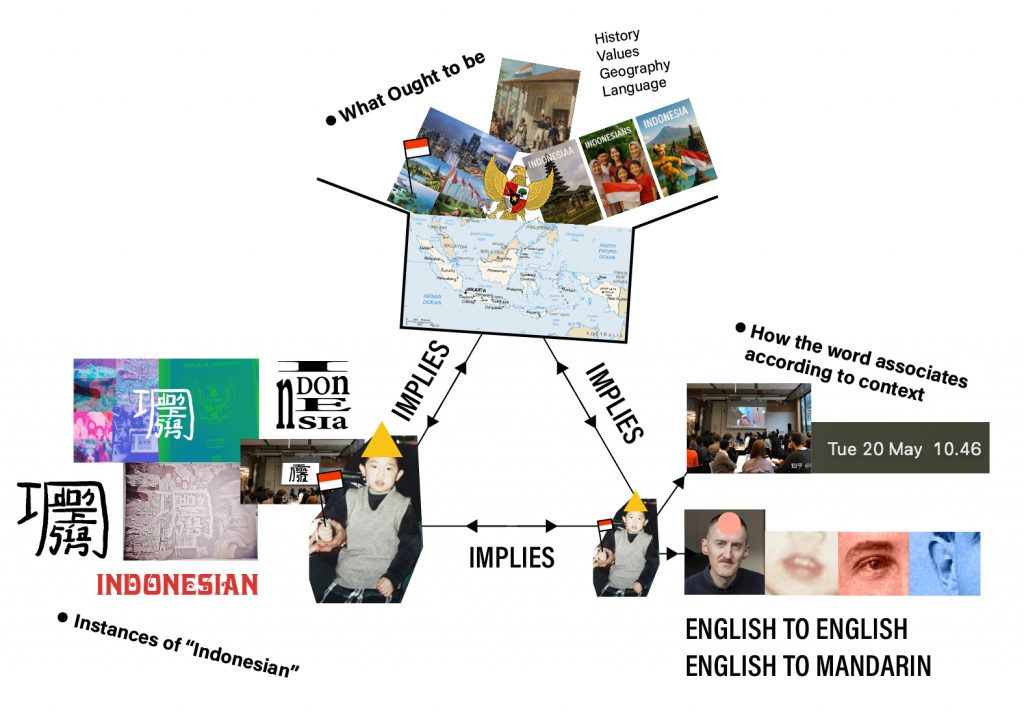
When we talk about a term, for example, “Indonesian” in the sense of national identity, three aspects always support its existence: Classificational, Instatiational, and Associational. An Indonesian has defining qualities that classifies any instances as “indonesian” such as nationalistic values, implies the existence of a country in a certain geographical area, in a specific time, etc.. An Indonesian is not a Malaysian, or Chinese. An Indonesian has unlimited ways of manifesting itself in instances across time, context, and form. It includes any specific indonesian person, images of an indonesian, writings, utterances in any dialect etc.. Finally all above inseparably implies the existence of infinite cases of contexts in which these instances exist in, it could be when the word is uttered, to whom, what biases they might have, what distortions resulted from the TV used to present my presentations, and so on.
This means my multi-layered background of western upbringings, faith, and difference in language all include as part of my context as an Indonesian, adhering to Indonesian values that apply inclusively without differentiating race and ethnicity.
I think this answers the challenges I mentioned above from the modernists, and from Le Guin’s theories of meaning. Meaning isn’t solely reliant on efficiency and overcoming barriers. The noise is part of the meaning and nuance is irreducible in the enrichment of meaning. While, communication is indeed interpersonal, but there is an underlying structure and a context with intent that drives the formation of meaning, not simply passive harmonization.
Yet there are also questions that could be asked about Triperspectivalism, such as how does lies and misinformation fit in the equation? How about the challenges of cultural barriers?
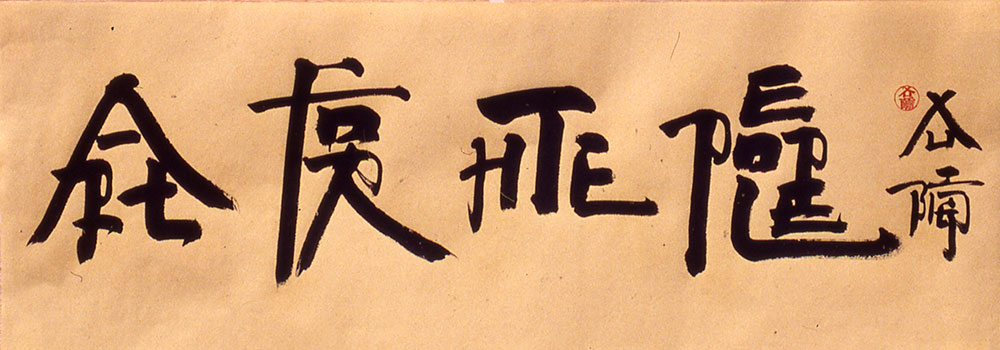
Bing, X. (1992) Square Word Calligraphy System [Ink on Paper]. [Online] Available at https://www.youtube.com/watch?v=eoB6wRkOOxY
Xu Bing’s Square Word Calligraphy System (1999-current) explores the idea of written language and its accessibility through a playful satirical rendition of latin calligraphy in the form of traditional chinese characters. These letters are rearranged the way traditional Chinese characters are structured, written from left-right, top-down, outside-in, all within a square format. The work deconstructs perception and understanding, juxtapositioning our expectations through its form and the actual readability, revealing our own cultural and linguistic subjective contexts.
This chart breaks down Xu Bing’s journey before the creation of his square word system. Xu Bing grew up with a librarian mother and historian father in China before the cultural revolution. When the cultural revolution happened, his father was jailed and his mother sent to a re-education camp. He was separated from his family. Due to his artistic talents, eventually he was recruited to write propaganda calligraphy everywhere by the communist government. This is where he felt the biggest change in the Chinese writing language, the arbitrariness of modifying symbols of words, changing its meaning to serve a political agenda.
After the revolution ended, China opened up its borders to the world and Xu Bing took the opportunity to work in New York. His exposure to the English language drove him to experiment with mixing latin script with mandarin calligraphy.
Heavily influenced by Xu Bing’s square word calligraphy, I have adapted and recontextualized that story to represent my ethnic Chinese Indonesian identity. A clash of cultural west and east in one form. This juxtaposition aims to create a contrast, much like René Magritte’s depiction of a pipe, highlighting the tension arising from the interplay of different visual cultural cues—Chinese, Indonesian, and Western—all anchored by the declarative statement “I am Indonesian.” The following series of compositions of different words with their accompanying images work together and is a set, inseparable from each other.
Using the modernists language of Eames, this cultural visual aspect would be considered as a form of “noise”, unnecessary distractions that hinder the clarity of the intended symbol. However, as Ursula K. Le Guin suggests, incorporating this “noise” can enrich and alter the meaning of words. Personalizing the context, for instance, by associating the word “Indonesian” with my own identity, transforms it into a unique expression of my nuanced nationality. Using the triadic structure by poythress, this would classify as an Indonesia’s cultural expression, in the instances of myself, working on this particular brief with specific selection of images from my gallery and old photos, calligraphic hand and different ways of pronouncing “Indonesian”, including the distorted sound waves demonstrated before. All this in association within the context of academia of UAL.
In conclusion, the Triperspectivalist approach to the developing meaning from terms answers the reductionist problem inherent in by Eames, Ogden-Richards, and Neurath’s modernist systems, as well the problem of structure and direction in Le Guin’s approach. The Triperspectivalist approach, in tandem with Indonesia pluralistic values work to validate one’s mixed heritage between eastern and western cultures. Communication and connection between the two identities, east and west, are possible due to an underlying semantic, social and language structures that supports them. Also the stability of said structure sustained by divine presence.
Leave a Reply